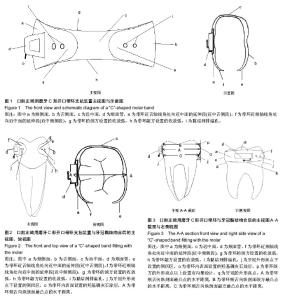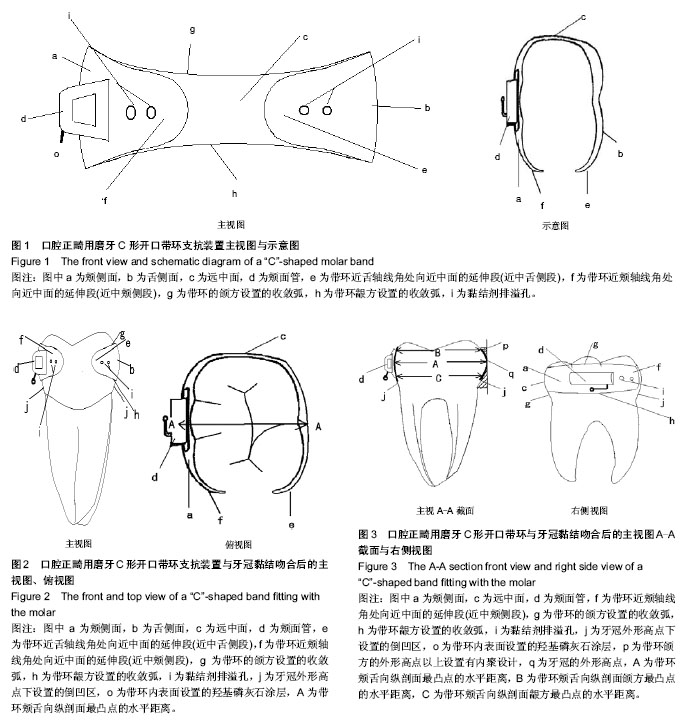Chinese Journal of Tissue Engineering Research ›› 2014, Vol. 18 ›› Issue (34): 5480-5484.doi: 10.3969/j.issn.2095-4344.2014.34.012
Previous Articles Next Articles
Development of a new open “C”-shaped molar band with nanomaterial
Zhou Shan1, Lu Xiao-li1, Yang Li-jun1, Li Yao2, Zhang Yu2, Zhang Xiao-peng2
- 1Department of Orthodontics, Second Affiliated Hospital of Harbin Medical University, Harbin 150086, Heilongjiang Province, China; 2Department of Materials, Harbin Institute of Technology, Harbin 150000, Heilongjiang Province, China
-
Revised:2014-07-15Online:2014-08-20Published:2014-08-20 -
Contact:Zhou Shan, Department of Orthodontics, Second Affiliated Hospital of Harbin Medical University, Harbin 150086, Heilongjiang Province, China -
About author:Zhou Shan, M.D., Associate chief physician, Department of Orthodontics, Second Affiliated Hospital of Harbin Medical University, Harbin 150086, Heilongjiang Province, China -
Supported by:the Scientific Research Project of Heilongjiang Education Bureau, No. 11531204
CLC Number:
Cite this article
Zhou Shan, Lu Xiao-li, Yang Li-jun, Li Yao, Zhang Yu, Zhang Xiao-peng. Development of a new open “C”-shaped molar band with nanomaterial[J]. Chinese Journal of Tissue Engineering Research, 2014, 18(34): 5480-5484.
share this article

口腔正畸用磨牙C型开口带环由带环的颊侧面a、带环的舌侧面b、带环的远中面c、带环的颊面管d、带环近舌轴线角处向近中面的延伸段e(近中舌侧段)、带环近颊轴线角处向近中面的延伸段f(近中颊侧段)组成;颊侧面a、舌侧面b、远中面c三个主面上有带环的颌方g及龈方h设置的收敛弧;近中舌侧段e和近中颊侧段f上设置有黏结剂排溢孔i;牙冠外形高点下设置有倒凹区j;带环内表面设置有羟基磷灰石涂层o;带环颌方的外形高点以上设置有内聚设计p;还有牙冠的外形高点q,带环颊舌向纵剖面最凸点的水平距离A,带环颊舌向纵剖面颌方最凸点的水平距离B,带环颊舌向纵剖面龈方最凸点的水平距离C(图1-3)。 口腔正畸用磨牙C形开口纳米带环可以分为大、中、小3种规格,其周长分别为24.5 mm、32 mm或39 mm,厚度为0.18-0.20 mm。该带环的材质为1Cr18Ni9不锈钢。"

| [1] 娄清玲.粘接型颊面管在固定正畸中的应用[J].中国当代医学, 2007,3(2):63-64.
[2] 尹艳春,侯景秋,彭惠,等.直接粘接型颊面管在正畸中的应用现状和前景[J].国际口腔医学杂志,2010,37(2):214-217.
[3] 袁元.直接粘接颊面管与带环颊面管在直丝弓矫治技术中的对比研究[J].临床口腔医学杂志,2007,23(4):231-232.
[4] 刘文,王艳,沈红.磨牙带环与粘接式颊面管的临床应用比较[J].实用口腔医学杂志,2009,25(1):135-136.
[5] Dowsing P,Benson PE. Molar band re-use and decontamination: A survey of Specialists. J Orthod. 2006; 33(1):30-37.
[6] Fulford MR, Ireland AJ, Main BG. Decontamination of tried-in orthodontic molar bands. Eur J Orthod. 2003;25(6):621-622.
[7] 周卉,陈文杰.固定正畸中使用颊面管支抗牙与使用带环支抗牙卫生状况临床研究[J].医学研究杂志,2006,35(10):634-636.
[8] 徐宏志,滕瑜,李阳飞,等.固定正畸儿童的牙周状况分析[J].牙体牙髓牙周病学杂志,2004,14(11):145.
[9] 胡炜,傅民魁.正畸治疗中的口腔健康教育和卫生保健[J].中华口腔医学杂志, 2006,41(5):313-315.
[10] Millett DT,Hallgren A,Fornell A,et al.Bonded molar tubes: a retrospective evaluation of clinical performance. Am J Orthod Dentofacial Orthop.1999;115:667-674.
[11] Mandall NA,Millett DT,Mattick CR,et al.Orthodontic adhesives: a systematic review. J Orthod.2002;29:205-210.
[12] Laureano Filho JR,Godoy F,O'Ryan F.Orthodontic bracket lost in the airway during orthognathic surgery. Am J Orthod Dentofacial Orthop. 2008;134(2):288-290.
[13] Wenger NA, Atack NE,Mitchell CN,et al.Peri-operative second molar tube failure during orthognathic surgery:two case reports.J Orthod. 2007;34(2):75-79.
[14] Santoro M,Ayoub ME,Pardi VA,et al.Mesiodistal crown dimensions and tooth size discrepancy of the permanent dentition of Dominican Americans. Angle Orthod. 2000; 70(4): 303-307.
[15] Bolton WA.The clinical application of a tooth size analysis. Am J Orthod.1962;48(40): 504-529.
[16] Yuen KK,So LL,Tang EL.Mesiodistal crown diameters of the primary and permanent teeth in southern Chinese--a longitudinal study.Eur J Orthod. 1997;19(6):721-731.
[17] Doris JM, Bernard BW,Kuftinec MM, et al.A biometric study of tooth size and dental crowding. Am J Orthod. 1981;79(3): 326-336.
[18] Zachrisson BJ.A posttreatment evaluation of direct bonding in orthodontics.Am J Orthod. 1977;71(2):173-189.
[19] Geiger AM, Gorelick J, Gwinnett AJ.Bond failure rates of facial and lingual attachments.J Clin Orthod. 1983;17(3): 165-169.
[20] Zachrisson BU. Direct bonding in orthodontic treatment and retention a post-treatment evalution. Eur J Orthod. 2007; 29(Suppl 1): 28-134.
[21] Bands P,Macfarlane T. Bonded versus bandedfirst molar attachments: a randomized controlled clinical trial. J orthod. 2007;34:128-136.
[22] Panolis N,Christensen L,Eliades T. Long-term clinical failure rate of molar tubes bonded with a self-etching primer. Angle Orthod. 2005;75:1000-1002.
[23] Malkoc S, Corekci B, Botsali HE,et al. Cytotoxic effects of resin-modified orthodontic band adhesives. Are they safe? Angle Orthod. 2010;80(5):890-895.
[24] Banks P, Macfarlane TV.Bonded versus banded first molar attachments:a randomized controlled clinical trial. J Orthod. 2007;34(2):128-36.
[25] Nanda R.Biomechanics in clinical orthodoniies. USA. WB. Sunadesr,1997.
[26] Sugimoto T, Zhou X.Synthesis of uniform anatase TiO2 nanoparticles by the gel-sol method 2. Adsorption of OH-Ions to Ti(OH)4 gel and TiO2 particles. J Colloid Interface Sci. 2002;252(2):347-353.
[27] Sugimoto T, Okada K, Itoh H.Synthetic of Uniform Spindle-Type Titania Particles by the Gel-Sol Method.J Colloid Interface Sci. 1997;193(1):140-143. |
| [1] | Chen Ziyang, Pu Rui, Deng Shuang, Yuan Lingyan. Regulatory effect of exosomes on exercise-mediated insulin resistance diseases [J]. Chinese Journal of Tissue Engineering Research, 2021, 25(25): 4089-4094. |
| [2] | Chen Yang, Huang Denggao, Gao Yuanhui, Wang Shunlan, Cao Hui, Zheng Linlin, He Haowei, Luo Siqin, Xiao Jingchuan, Zhang Yingai, Zhang Shufang. Low-intensity pulsed ultrasound promotes the proliferation and adhesion of human adipose-derived mesenchymal stem cells [J]. Chinese Journal of Tissue Engineering Research, 2021, 25(25): 3949-3955. |
| [3] | Yang Junhui, Luo Jinli, Yuan Xiaoping. Effects of human growth hormone on proliferation and osteogenic differentiation of human periodontal ligament stem cells [J]. Chinese Journal of Tissue Engineering Research, 2021, 25(25): 3956-3961. |
| [4] | Sun Jianwei, Yang Xinming, Zhang Ying. Effect of montelukast combined with bone marrow mesenchymal stem cell transplantation on spinal cord injury in rat models [J]. Chinese Journal of Tissue Engineering Research, 2021, 25(25): 3962-3969. |
| [5] | Gao Shan, Huang Dongjing, Hong Haiman, Jia Jingqiao, Meng Fei. Comparison on the curative effect of human placenta-derived mesenchymal stem cells and induced islet-like cells in gestational diabetes mellitus rats [J]. Chinese Journal of Tissue Engineering Research, 2021, 25(25): 3981-3987. |
| [6] | Hao Xiaona, Zhang Yingjie, Li Yuyun, Xu Tao. Bone marrow mesenchymal stem cells overexpressing prolyl oligopeptidase on the repair of liver fibrosis in rat models [J]. Chinese Journal of Tissue Engineering Research, 2021, 25(25): 3988-3993. |
| [7] | Liu Jianyou, Jia Zhongwei, Niu Jiawei, Cao Xinjie, Zhang Dong, Wei Jie. A new method for measuring the anteversion angle of the femoral neck by constructing the three-dimensional digital model of the femur [J]. Chinese Journal of Tissue Engineering Research, 2021, 25(24): 3779-3783. |
| [8] | Meng Lingjie, Qian Hui, Sheng Xiaolei, Lu Jianfeng, Huang Jianping, Qi Liangang, Liu Zongbao. Application of three-dimensional printing technology combined with bone cement in minimally invasive treatment of the collapsed Sanders III type of calcaneal fractures [J]. Chinese Journal of Tissue Engineering Research, 2021, 25(24): 3784-3789. |
| [9] | Qian Xuankun, Huang Hefei, Wu Chengcong, Liu Keting, Ou Hua, Zhang Jinpeng, Ren Jing, Wan Jianshan. Computer-assisted navigation combined with minimally invasive transforaminal lumbar interbody fusion for lumbar spondylolisthesis [J]. Chinese Journal of Tissue Engineering Research, 2021, 25(24): 3790-3795. |
| [10] | Hu Jing, Xiang Yang, Ye Chuan, Han Ziji. Three-dimensional printing assisted screw placement and freehand pedicle screw fixation in the treatment of thoracolumbar fractures: 1-year follow-up [J]. Chinese Journal of Tissue Engineering Research, 2021, 25(24): 3804-3809. |
| [11] | Shu Qihang, Liao Yijia, Xue Jingbo, Yan Yiguo, Wang Cheng. Three-dimensional finite element analysis of a new three-dimensional printed porous fusion cage for cervical vertebra [J]. Chinese Journal of Tissue Engineering Research, 2021, 25(24): 3810-3815. |
| [12] | Wang Yihan, Li Yang, Zhang Ling, Zhang Rui, Xu Ruida, Han Xiaofeng, Cheng Guangqi, Wang Weil. Application of three-dimensional visualization technology for digital orthopedics in the reduction and fixation of intertrochanteric fracture [J]. Chinese Journal of Tissue Engineering Research, 2021, 25(24): 3816-3820. |
| [13] | Sun Maji, Wang Qiuan, Zhang Xingchen, Guo Chong, Yuan Feng, Guo Kaijin. Development and biomechanical analysis of a new anterior cervical pedicle screw fixation system [J]. Chinese Journal of Tissue Engineering Research, 2021, 25(24): 3821-3825. |
| [14] | Lin Wang, Wang Yingying, Guo Weizhong, Yuan Cuihua, Xu Shenggui, Zhang Shenshen, Lin Chengshou. Adopting expanded lateral approach to enhance the mechanical stability and knee function for treating posterolateral column fracture of tibial plateau [J]. Chinese Journal of Tissue Engineering Research, 2021, 25(24): 3826-3827. |
| [15] | Zhu Yun, Chen Yu, Qiu Hao, Liu Dun, Jin Guorong, Chen Shimou, Weng Zheng. Finite element analysis for treatment of osteoporotic femoral fracture with far cortical locking screw [J]. Chinese Journal of Tissue Engineering Research, 2021, 25(24): 3832-3837. |
| Viewed | ||||||
|
Full text |
|
|||||
|
Abstract |
|
|||||